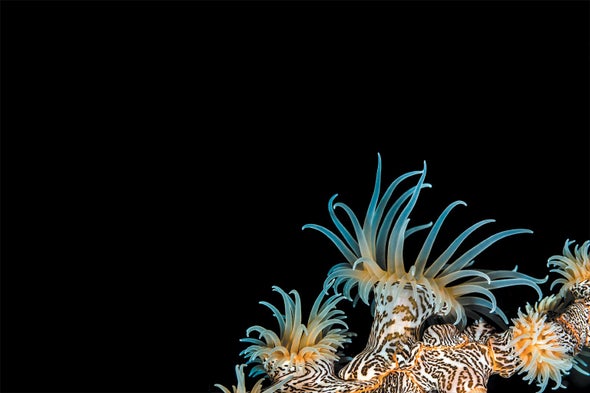Edited by Dava Sobel
It is perhaps not strange that the Radiates, a type of animals
whose home is in the sea, many of whom are so diminutive
in size, and so light and evanescent in substance, that they
are hardly to be distinguished from the element in which
they live, should have been among the last to attract the
attention of naturalists.
They say I came to science
through marriage. As though
I wouldn't have, otherwise.
As though I was dragged, by accident,
like a jellyfish caught in a net.
The truth is I married for science.
It was a way in. Like
a radiate, I got what I wanted
without attracting undue attention.
Nothing can be more unprepossessing than a sea-anemone
when contracted. A mere lump of brown or whitish jelly, it
lies like a lifeless thing on the rock to which it clings, and it is
difficult to believe that it has an elaborate and exceedingly
delicate internal organization, or will ever expand into such
grace and beauty as really to deserve the name of the flower
after which it has been called ... the whole summit of the
body seems crowned with soft, plumy fringes.
We are all lumps, aren't we, before we find
the thing we love? The things?
My husband and I, lumped together,
blossomed into beauty. I know
that sounds maudlin. Let me try again.
These animals ... thrive well in confinement.
For some women, marriage is a prison.
They enter it willingly. It keeps them
safe from the world. Our marriage
was more like a boat.
They may also multiply by a process of self-division.
We had no children. I took notes.
Another way of saying it is I wrote books.
At every point in our studies
of sea creatures and each other,
I was in charge of the words.
The name Jelly-fish is an inappropriate one, though the
gelatinous consistency of these animals is accurately enough
expressed by it; but they have no more structural relation
to a fish than to a bird or an insect.
Jellyfish are neither jelly nor fish,
as I was not truly wife nor scientist.
Have you seen them move?
It looks as if they move by breathing.
Encountering one of those huge Jelly-fishes, when out
in a row-boat one day, we attempted to make a rough
measurement of his dimensions upon the spot. He was
lying quietly near the surface, and did not seem in the
least disturbed by the proceeding, but allowed the oar,
eight feet in length, to be laid across the disk, which
proved to be about seven feet in diameter. Backing the
boat slowly along the line of the tentacles, which were
floating at their utmost extension behind him, we then
measured these in the same manner, and found them to
be rather more than fourteen times the length of the oar...
As I write these lines I remember
that day in the boat and how happy
we were. A person could measure
our happiness in oars. A person could
lay down oar after oar and still need
more oars.
Our laughter echoing over the waves.
No one to hear it besides each other—
and the biggest jellyfish we ever saw.
Author's Note: All italic quotations are from Agassiz's Seaside Studies in Natural History (1865). In addition to her scientific research, Agassiz collaborated with her husband, natural historian Louis Agassiz, on marine expeditions. She was a co-founder and the first president of Radcliffe College.


